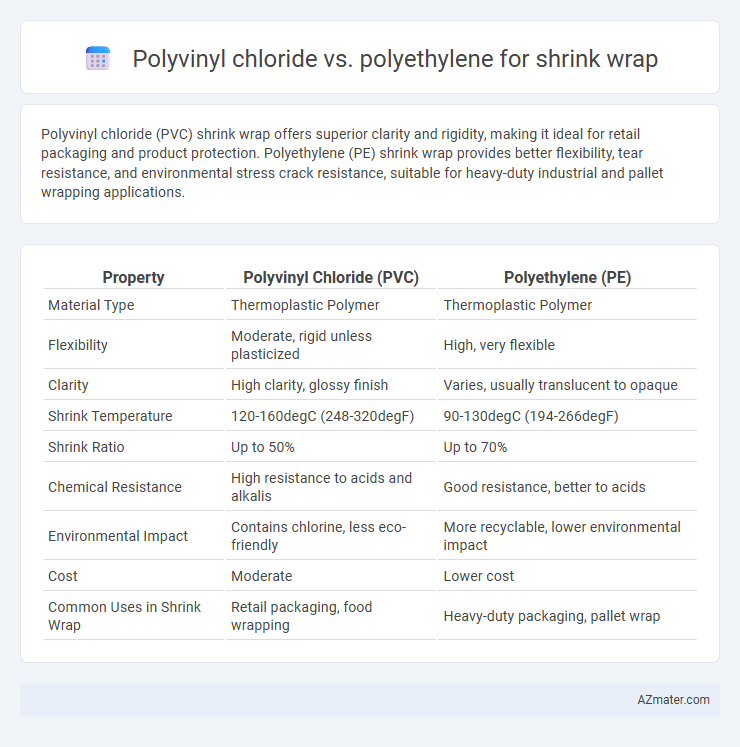Polyvinyl chloride (PVC) shrink wrap offers superior clarity and rigidity, making it ideal for retail packaging and product protection. Polyethylene (PE) shrink wrap provides better flexibility, tear resistance, and environmental stress crack resistance, suitable for heavy-duty industrial and pallet wrapping applications.
Table of Comparison
| Property | Polyvinyl Chloride (PVC) | Polyethylene (PE) |
|---|---|---|
| Material Type | Thermoplastic Polymer | Thermoplastic Polymer |
| Flexibility | Moderate, rigid unless plasticized | High, very flexible |
| Clarity | High clarity, glossy finish | Varies, usually translucent to opaque |
| Shrink Temperature | 120-160degC (248-320degF) | 90-130degC (194-266degF) |
| Shrink Ratio | Up to 50% | Up to 70% |
| Chemical Resistance | High resistance to acids and alkalis | Good resistance, better to acids |
| Environmental Impact | Contains chlorine, less eco-friendly | More recyclable, lower environmental impact |
| Cost | Moderate | Lower cost |
| Common Uses in Shrink Wrap | Retail packaging, food wrapping | Heavy-duty packaging, pallet wrap |
Introduction to Shrink Wrap Materials
Shrink wrap materials primarily consist of polyvinyl chloride (PVC) and polyethylene (PE), each offering distinct chemical and physical properties ideal for packaging. PVC provides clarity, strength, and sealability with excellent resistance to punctures, making it suitable for retail packaging and product display. Polyethylene, especially low-density polyethylene (LDPE) and linear low-density polyethylene (LLDPE), offers greater flexibility, moisture resistance, and environmental resistance, favored for industrial applications and bulk packaging.
Overview of Polyvinyl Chloride (PVC)
Polyvinyl chloride (PVC) is widely used in shrink wrap applications due to its excellent clarity, strength, and ability to conform tightly to products when heated. Its chemical resistance and durability make it suitable for protecting items during shipping and storage, offering a balance between rigidity and flexibility. Unlike polyethylene, PVC shrink film provides superior gloss and barrier properties, enhancing product presentation and protection.
Overview of Polyethylene (PE)
Polyethylene (PE) is a versatile thermoplastic widely used in shrink wrap applications due to its excellent flexibility, moisture resistance, and clarity. Its low-density polyethylene (LDPE) variant provides superior stretchability and sealability, making it ideal for packaging irregularly shaped products. Compared to polyvinyl chloride (PVC), PE exhibits higher chemical resistance, lower environmental impact, and better puncture resistance, enhancing overall packaging durability.
Physical Properties Comparison: PVC vs. PE
Polyvinyl chloride (PVC) exhibits superior clarity, higher tensile strength, and better chemical resistance compared to polyethylene (PE), making it suitable for applications requiring robust shrink wrap performance. Polyethylene, especially low-density polyethylene (LDPE), offers greater flexibility, improved elongation, and lower sealing temperatures, which enhances ease of processing and energy efficiency during shrink wrapping. The choice between PVC and PE depends on the desired balance between rigidity, clarity, and thermal shrink characteristics essential for specific packaging requirements.
Clarity and Aesthetics in Shrink Wrap Applications
Polyvinyl chloride (PVC) offers superior clarity and gloss compared to polyethylene (PE), making it ideal for shrink wrap applications where visual appeal is crucial. PVC's higher transparency enhances product visibility, providing a sleek, professional finish that is favored in retail packaging. In contrast, polyethylene tends to have a hazier appearance, which can diminish the aesthetic quality of shrink-wrapped items.
Strength and Durability: Which Material Lasts Longer?
Polyvinyl chloride (PVC) shrink wrap offers superior strength and resistance to punctures compared to polyethylene (PE), making it more durable for long-term applications. PVC's rigidity and chemical resistance allow it to maintain its form and protect contents under harsh conditions, whereas polyethylene is more flexible but less resistant to tears and environmental stress. For longevity and robust protection, PVC shrink wrap generally outperforms polyethylene in strength and durability parameters.
Sealability and Shrink Performance
Polyvinyl chloride (PVC) offers superior sealability due to its strong heat-sealing properties, making it ideal for shrink wrap applications requiring reliable package integrity. Polyethylene (PE) demonstrates better shrink performance with higher shrink ratio and faster shrink speed, providing excellent contouring around various product shapes. The choice depends on the specific requirements for durability and appearance, as PVC ensures tight seals while PE excels in uniform and rapid shrinkage.
Environmental Impact: Sustainability and Recycling
Polyvinyl chloride (PVC) shrink wrap poses environmental challenges due to its chlorine content, which can release harmful dioxins during production and incineration, making recycling complex. Polyethylene (PE) shrink wrap, especially low-density polyethylene (LDPE), is more environmentally sustainable as it is chlorine-free, easier to recycle, and generates fewer toxic emissions. The higher recyclability of PE contributes to reduced landfill waste and lower environmental impact compared to PVC in shrink wrap applications.
Cost Efficiency and Market Availability
Polyethylene dominates the shrink wrap market due to its lower production cost and widespread availability compared to polyvinyl chloride (PVC). Polyethylene offers superior cost efficiency with cheaper raw materials and easier processing, making it the preferred choice for bulk applications. Despite PVC's durability advantages, its higher price and limited supplier presence constrain its market share in shrink wrap.
Best Use Cases: Choosing Between PVC and PE for Shrink Wrap
Polyethylene (PE) shrink wrap is ideal for packaging irregularly shaped items, offering excellent flexibility, moisture resistance, and durability, making it perfect for food, electronics, and pallet wrapping. Polyvinyl chloride (PVC) shrink wrap provides superior clarity and stiffness, best suited for retail packaging where product visibility and a tight, professional seal are essential. Selecting between PVC and PE depends on specific requirements such as environmental exposure, product protection needs, and aesthetic preferences.

Infographic: Polyvinyl chloride vs Polyethylene for Shrink wrap
 azmater.com
azmater.com